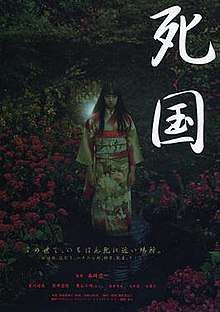Shikoku (film)
Shikoku (死国, "Land of The Dead") is a 1999 Japanese supernatural thriller film directed by Shunichi Nagasaki and written by Kunimi Manda and Takenori Sento.
| Shikoku | |
|---|---|
 Japanese film poster for Shikoku | |
| Directed by | Shunichi Nagasaki |
| Produced by |
|
| Screenplay by |
|
| Story by | Masako Bando[1] |
| Music by | Sotoshi Kadokura[1] |
| Cinematography | Noboru Sinoda[1] |
| Edited by | Yoshiyuki Okuhara[1] |
Production company | Asmik Ace Entertainment[1] |
| Distributed by | Toho |
Release date |
|
Running time | 100 minutes[1] |
| Country | Japan |
| Language | Japanese |
Plot summary
Years after moving to Tokyo with her parents, Hinako returns to her hometown in rural Shikoku. She soon learns that her childhood friend, Sayori, died several years ago and that Sayori's mother, a Shinto priestess(?) who used to perform séances and exorcisms, has gone almost insane with grief. After seeing Sayori's yūrei several times during the night, Hinako consults with some local experts on the paranormal and discovers that Sayori's mother has something planned for her daughter.
Cast
- Yui Natsukawa as Hinako Myoujin
- Michitaka Tsutsui as Fumiya Akizawa
- Chiaki Kuriyama as Sayori Hiura
- Toshie Negishi as Teruko Hiura (Sayori's mother)
- Ren Osugi as Yasutaka Hiura (Sayori's father)
- Makoto Satô as Sendo
- Taro Suwa as Oda
- Tomoko Otakara as Yukari Asakawa
- Haduki Kôzu as Chizuko Oono
Release
Shikoku was released in Japan on January 23, 1999 where it was distributed by Toho.[1] It was released as a double feature with Ring 2.[2] Shikoku was later shown at the Vancouver International Film Festival as part of a program of modern Japanese horror films at the festival, including Ring, Ring 2, Audition and Gemini.[3]
The film was released directly to video in the United States on October 26, 2004 by Adness.[1]
Reception
Jasper Sharp writing for Midnight Eye referred to the film as a "pedestrian addition to the late 1990s horror boom.", finding it "Hideo Nakata's high-concept popcorn movie Ring had proven pretty convincingly that the supernatural could be a lucrative cash cow in late-1990s recessional Japan. A contract job, co-written by one of Ring's original producers, Takenori Sento, and circulating on the lower half of a double bill with Ring 2, Shikoku is less an indication of either Bando or Nagasaki's thematic interests than an obvious attempt to milk the current interest in horror before it dried up. As such, it doesn't deviate too far from the path forged by its model in either style or formula.[4] John Kenneth Muir in his book Horror Films of the 1990s gave the film a three and a half star rating out of five, finding the film "Beautifully shot and visually realized" and that the film had "more on its mind than scary dead girls with long hair"[5][6]
References
- Galbraith IV 2008, p. 405.
- Kalat 2008, p. 277.
- Andrews, Mark (September 23, 1999). "Looking to the Future: The Vancouver International Film Festival doesn't want its audience to go grey, but it's tough to sell art films to the young". The Vancouver Sun. Infomart. p. C20. ISSN 0832-1299.
- Sharp, Japser (March 20, 2001). "Shikoku". Midnight Eye. Retrieved October 24, 2015.
- Muir 2011, p. 641.
- Muir 2011, p. 642.
Bibliography
- Galbraith IV, Stuart (2008). The Toho Studios Story: A History and Complete Filmography. Scarecrow Press. ISBN 1461673747.CS1 maint: ref=harv (link)
- Kalat, David (2007). J-Horror. Vertical Inc. ISBN 978-1-932234-08-4.CS1 maint: ref=harv (link)
- Muir, John Kenneth (2011). Horror Films of the 1990s. McFarland. ISBN 978-0-7864-4012-2.CS1 maint: ref=harv (link)